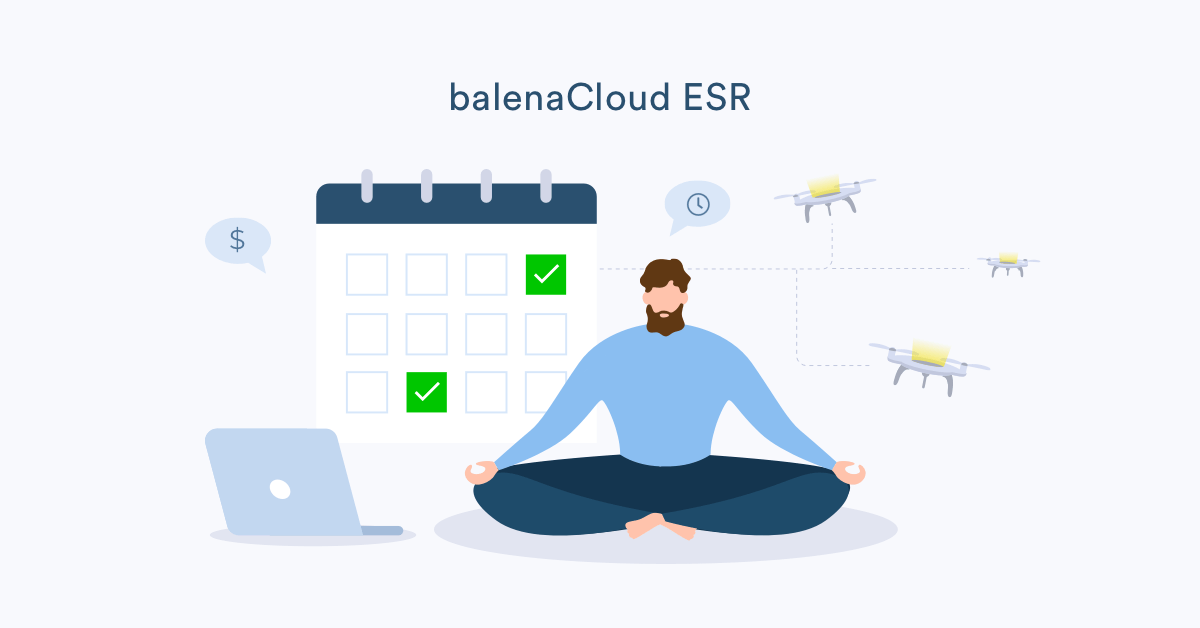We’re excited to announce the Extended Support Release (ESR) line of operating system for Production and Enterprise fleets using balenaCloud. ESR makes it easier for at-scale fleet owners to have a more predictable OS update schedule while ensuring critical security or bug fixes are not missed.
Who does ESR affect the most?
This new OS release cadence is most critical for fleet owners and managers using balenaCloud who work with field devices that are bandwidth-constrained or have very long OS verification processes. The ESR operating system type is available to Production and Enterprise-type balenaCloud users.
What is Extended Support Release (ESR)?
The ESR process enables fleet owners with bandwidth-constrained or very long OS verification processes to keep their devices secure and reliable with, at most, two upgrades a year. New ESR operating system versions are released on a three-month schedule, and as such, fleet owners know in advance when releases will be available and when they need to upgrade.
Each ESR release is supported for nine months from the time of release. A supported ESR version implies that high-risk security vulnerabilities and critical stability bug fixes will be backported to that version. Backports of any functional enhancements are not in scope and one can be confident that no interface changes have occurred within a line (we explain lines further below).
Why is this important to certain fleet owners at scale?
ESR is especially important to fleet owners managing numerous remote devices on balenaCloud who encounter one or more of these situations:
- Compliance with long OS verification processes: It can cost a lot of time and money for fleet owners to run new OS versions through acceptance cycles and testing before they can actually release them to devices during one upgrade, let alone having to do so numerous times a year
- High costs of bandwidth usage at fleet scale: Updating the OS for an entire fleet’s worth of devices multiple times a year can lead to high costs if you’re paying per data transfer, per device.
These two situations make fleet owners ask themselves, “How many updates does my fleet actually need per year?”
Given our release schedule, it will be possible for our users to stay on major OS versions that belong to ESR by only updating twice a year. ESR versions only backport critical fixes, meaning fleet owners don’t have to fully retest OSes each time, as no functionality or interface changes will occur. This means our users can then update their devices however many times as needed without breaking the interface (there is no need to retest everything before updating).
Filtering within balenaCloud helps informs users as to when it’s critical to update their fleet, allowing them to better orchestrate updates across devices during these more challenging use cases and conditions.
How do the ESR lines and schedule work?
Three lines of ESR versions are supported, known as next, current, and sunset. Every three months, a new ESR version is released, and each line will transition forward at that time as illustrated on the following diagram:

ESR schedule example, with details on how one specific version progresses.
Here’s a generalized way to read the diagram. A master version is chosen to become the next-ESR, then three months (or one quarter) later, it becomes current-ESR, and then a quarter after that, it becomes a sunset-ESR.
Let’s walk through an example with the diagram using a specific ESR version, 2019.10:
- An ESR version is released known as
2019.10based on master version 2.44, which becomes the next-ESR - In three months, a new ESR version, i.e.,
2020.01, becomes the next-ESR line, while 2019.10 transitions to become the current-ESR - Similarly, in a further three months, there is a new ESR version, and
2019.10becomes the sunset-ESR
Three months after that, and nine months after release, the 2019.10 ESR version will reach its end-of-life, and no further updates will be offered on this version. Users should update to one of the supported releases to receive future updates by performing a self-service update.
Supported devices as of this announcement
We will release support for these device types following this announcement:
- Balena Fin
- Raspberry Pi (v1 and Zero)
- Raspberry Pi 3
- Raspberry Pi 4
- Beaglebone
- Intel NUC
- NVIDIA Jetson TX2
Additional versions or hardware will be consistently updated on our ESR documentation.
How do I use the ESR today?
Today the ESR operating system type is available to Production and Enterprise plan customers using balenaCloud. We will initially be rolling out ESR to the supported device types (mentioned above).
Start learning more about the ESR OS by visiting our documentation. If you have questions or comments, let us know in our forums.

